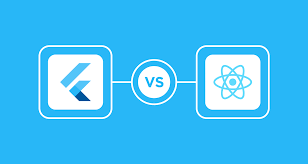Cross-platform app development is gaining ground swiftly in the corporate world and for good reasons! These apps can be run seamlessly across both Android and iOS platforms. Moreover, they remain highly cost-effective in development and maintenance. thanks to evolving technology. These days, many frameworks are available with many features and tools to build cross-platform applications.
Out of these platforms, Flutter and React Native have marked their presence in the developer’s community. React Native and Flutter app development services have their pros and cons in developing feature-rich business apps. In this post, we are going to see why Flutter has an upper hand over React Native with their respective key features.
Let’s start with the search engine giant Google’s future-ready framework, Flutter.
More: Top Mobile App Development Frameworks
What is Flutter and why is it important?
Flutter is an open-source UI software development kit (SDK) developed and maintained by Google. When building natively compiled mobile, web, and desktop applications from a single codebase, Flutter is a choice of developers globally. Google has developed a special programming language known as Dart for this framework.
Alibaba, Baidu, and Google Pay are some of the popular Flutter-powered applications.
Here are some key points that show the importance of Flutter:
- Native-like Performance
Flutter uses a rendering engine called Skia, which directly renders UI components to the screen. This results in high-performance mobile applications that can achieve near-native performance while having smooth animations, fast startup times, and excellent responsiveness.
- Hot Reload
Flutter’s hot reload feature is the most popular feature among developers. When you hire dedicated flutter app developers, they can see the changes they make in the code immediately reflected in the app’s interface using this feature. It accelerates the development process by allowing quick iterations and experimentation without the need for lengthy build times or restarting the app.
- Rich Set of Widgets
Flutter has a rich set of pre-built UI widgets that are highly customizable. These widgets allow developers to create visually appealing and interactive user interfaces. Flutter’s widgets also adapt to the platform’s design guidelines, providing a native look and feel across different devices.
- High Compatibility
Flutter offers platform channels that enable developers to access and use native features and APIs of the underlying operating system. Flutter app development services enable you to get the app compatible with iOS and Android platforms by supporting Cupertino and material design respectively.
- Growing Community
Flutter has gained significant popularity and its developer community is increasing continuously. This means there are abundant resources, libraries, packages, and plugins available, making it easier to find support, documentation, and solutions for various development needs.
- Fast Development Cycle
You can hire Flutter app developers who can rapidly develop and iterate on applications. The combination of hot reload, expressive UI components, and a reactive framework allows for efficient development cycles, reducing time-to-market and speeding up the overall development process.
- Single-Code Maintenance
Maintaining a single codebase across platforms simplifies the development process and reduces maintenance efforts. Changes and updates only need to be made once, eliminating the need for separate codebases for different platforms.
Overall, Flutter’s importance lies in its ability to streamline the app development process, deliver high-performance cross-platform applications, and provide an excellent user experience across different devices and operating systems.
React Native, on the other hand, is an open-source framework developed by Facebook. It allows developers to create native mobile apps using JavaScript and the React framework, which are capable of offering a native-like experience to users. React Native enables the development of apps that can run on both iOS and Android platforms, sharing a significant portion of the codebase.
Facebook, Walmart, and Instagram are some of the popular React Native applications.
Here are some key aspects and importance of React Native:
- Native-like performance
React Native utilizes native components and APIs, allowing apps to achieve native-like performance. It uses a bridge that communicates between JavaScript and native code, enabling efficient and smooth interaction between the app and the device’s native capabilities.
- Fast Refresh
It is a ‘hot reloading’ feature of React Native that enables developers to see the changes they make in the code immediately reflected in the app. This facilitates a faster development cycle and enables quick iterations and experimentation, enhancing productivity.
- Code Reusability
With React Native, developers can reuse code across different platforms, which can significantly reduce development time and effort. Although there may be some platform-specific code required for certain functionalities, a large portion of the codebase can be shared, making it easier to maintain and update the application.
- Large Community
React Native has a vast and active community of developers, which means there are abundant resources, tutorials, libraries, and plugins available. This extensive ecosystem provides support, documentation, and solutions for various development needs, making it easier for developers to find help and accelerate their development process.
- Third-party Compatibility
React Native has good compatibility with third-party libraries, allowing developers to easily integrate existing JavaScript libraries into their projects. This reduces the need for rewriting code or reinventing the wheel and enhances the overall development process.
- UI Flexibility
React Native allows developers to create highly flexible and dynamic user interfaces. It uses a declarative approach, where UI components are described using JavaScript and React components, providing a seamless and intuitive way to build interactive and visually appealing interfaces.
It is fair to mention that Flutter and React Native are both popular frameworks for developing cross-platform mobile applications. While both have their own strengths and weaknesses, Flutter is often preferred over React Native for several reasons:
Here we mention some key advantages of Flutter over React Native.
- Performance
Flutter has a performance advantage over React Native because it uses a rendering engine that directly compiles native code. This allows Flutter apps to achieve near-native performance, resulting in smoother animations, faster startup times, and better overall responsiveness.
- UI Consistency
Flutter provides a consistent UI across different platforms, including iOS and Android. It uses its own set of customizable UI widgets, which ensures that the app’s look and feel remain consistent across platforms, making it easier to create a cohesive user experience.
- Development speed
Flutter offers a faster development cycle compared to React Native. Since Flutter apps use a single codebase for multiple platforms, developers can write code once and deploy it on both iOS and Android devices. This reduces development time, as there’s no need to write separate codebases or maintain separate teams for each platform.
- Access to Native Features
Flutter provides direct access to native features and APIs through its platform channels, allowing developers to leverage the full capabilities of the underlying operating systems. This ensures that Flutter apps can make use of device-specific functionalities seamlessly.
Concluding Lines
In a nutshell, we can mention that the choice between Flutter and React Native ultimately depends on specific project requirements, team expertise, and personal preferences. You can consult a reputed react native app development company to know more about the Flutter framework and leverage its benefits for your upcoming business application.




